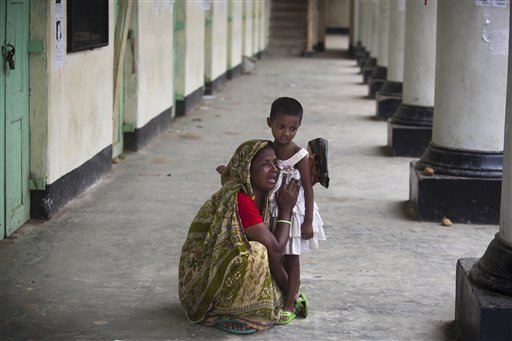(AP) Bangladesh to end search for collapse victims
By FARID HOSSAIN
Associated Press
DHAKA, Bangladesh
Bangladesh’s military is ending its search for bodies in the wreckage of an eight-story garment factory building that collapsed last month because no more are expected to be found, officials said Monday.
Also Monday, the government agreed to allow the country’s garment workers to form trade unions without permission from factory owners as part of growing concessions for industry reform following the building collapse.
Soldiers and other workers have recovered 1,127 bodies from the April 24 collapse, with none found since Sunday night.
A special prayer service will be held Tuesday to honor the dead, he said.
The collapse of the Rana Plaza building has focused global attention on hazardous conditions in Bangladesh’s powerful garment industry.
The Cabinet decision to allow trade unions came a day after the government announced a plan to raise the minimum wage for garment workers, who are paid some of the lowest wages in the world to sew clothing bound for global retailers. Both moves are seen as a direct response to the collapse of the building housing five garment factories, the worst disaster in the history of the global garment industry.
Government spokesman Mosharraf Hossain Bhuiyan said the Cabinet approved an amendment to the 2006 Labor Act lifting restrictions on forming trade unions in most industries. The old law required workers to obtain permission before they could unionize.
Local and international trade unions have long campaigned for such changes.
Though the 2006 law technically allowed trade unions _ and they exist in many of Bangladesh’s other industries _ owners of garment factories never allowed them, saying they would lead to a lack of discipline among workers.
Trade union leaders responded cautiously.
In recent years the government has cracked down on trade unions attempting to organize garment workers. In 2010 Hasina’s government launched an Industrial Police force to crush street protests by thousands of workers demanding better pay and working conditions.
That year police arrested at least six activists, including Akter, on charges of instigating workers to vandalize factories. They were later freed, but some charges are still pending.
The activists are also angry that police have made no headway in the investigation of the death of a fellow union organizer, Aminul Islam, who was found dead a day after he disappeared from his home in 2012.
On Sunday, the government set up a new minimum wage board that will issue recommendations for pay raises within three months, Textiles Minister Abdul Latif Siddiky said. The Cabinet will then decide whether to accept those proposals.
The wage board will include representatives of factory owners, workers and the government, he said.
Bangladesh is the third-biggest exporter of clothes in the world, after China and Italy. There are 5,000 factories in the country and 3.6 million garment workers.
But working conditions in the $20 billion industry are grim, a result of government corruption, desperation for jobs, and industry indifference. Minimum wages for garment workers were last raised by 80 percent to 3,000 takas ($38) a month in 2010 following protests by workers.
Since 2005, at least 1,800 garment workers have been killed in factory fires and building collapses in Bangladesh, according to research by the advocacy group International Labor Rights Forum.
In November, 112 workers were killed in a garment factory in Dhaka, the Bangladeshi capital. The factory lacked emergency exits, and its owner said only three floors of the eight-story building were legally built.
The Rana Plaza owner and eight other people, including garment factory owners, have been detained in the collapse investigation. Authorities say the building owner added floors to the structure illegally and allowed the factories to install heavy equipment that the building was not designed to support.
Workers using hydraulic cranes, bulldozers, shovels and iron cutters have removed most of the ruins of the fallen building, where thousands were working at the time of the disaster.
On Friday, the search teams received a much-needed morale boost when they found a seamstress who survived under the rubble for 17 days on dried food and bottled and rain water.

COMMENTS
Please let us know if you're having issues with commenting.